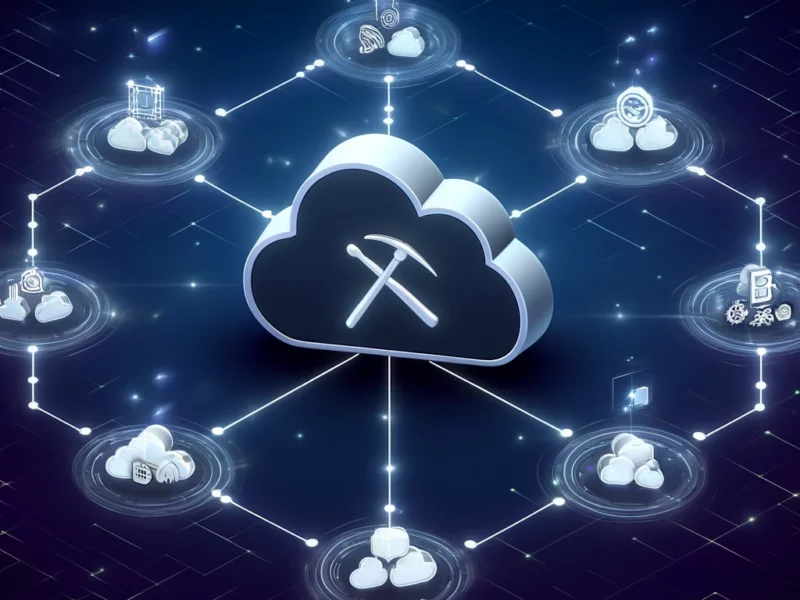Have you ever wondered if you could mine cryptocurrency using a virtual PC? Well, yes, you can, but there’s more to it than you think.
What is A Virtual PC?
A virtual PC, or virtual machine (VM), is like a computer within a computer. It’s software that emulates a physical computer, running an operating system and applications as if it were a separate physical entity. People use VMs for various reasons, from testing new software in a sandboxed environment to running applications that require different operating systems.
How Can One Mine Crypto on a Virtual PC?
Technicaly it’s possible to use a virtual PC for mining cryptocurrencies but the real question is whether it’s practical and profitable.
Mining requires substantial computational power, and virtual PCs share resources with the host machine. This sharing can limit the amount of power available for mining, potentially making it less efficient than mining on a dedicated physical machine.
Pros and Cons of Mining Crypto with a Virtual Machine
On the plus side, using a virtual PC for mining offers flexibility. You can easily switch between different operating systems and mining software without affecting your main system. It’s also a safer environment as it isolates the mining process from your primary operating system, reducing the risk of malware or other security issues associated with some mining applications.
However, the drawbacks are significant. The biggest issue is performance. Virtual PCs often have limited access to the host’s resources. This limitation can severely impact mining efficiency, as crypto mining is a resource-intensive task that requires powerful GPUs or ASICs (application-specific integrated circuits). Most virtual machines struggle to access the full potential of these hardware resources.
Especially when it comes to GPUs, GPUs (Graphics Processing Units) are the powerhouse behind most crypto mining operations, especially for processing-intensive coins. They’re much better than CPUs (Central Processing Units) for the parallel processing required in mining. But here’s the thing: most virtualization software has limitations in GPU passthrough capabilities. This means the virtual machine may not use the full potential of the GPU, leading to less effective mining.
Furthermore, when you’re mining crypto on a virtual PC, you’re sharing your computer’s resources—like the CPU, GPU, and RAM—between the host system and the virtual machine. This division is where the problem starts. Mining, especially for currencies like Bitcoin, requires intense computational power, primarily provided by GPUs. Virtual machines generally have limited access to these resources, which can drastically reduce mining efficiency.
And this is why experts strongly advise against using virtual PCs to mine certain coins (especially Bitcoin).
Potential Solutions for Efficiently Mining Crypto on Virtual PCs
Despite the challenges, there are some workarounds. Some advanced virtualization platforms allow better hardware passthrough, enabling the virtual machine to access more of the GPU’s power. Technologies like SR-IOV (Single Root Input/Output Virtualization) can help, but setting this up requires technical knowledge and the right kind of hardware.
Virtual PCs vs. Physical Mining Rigs
A physical mining rig is a computer set up specifically for mining. It usually includes multiple high-powered GPUs, optimal cooling solutions, and software tailored for mining. These rigs are designed to maximize the efficiency of mining operations.
In contrast, a virtual PC setup is typically not optimized for mining. The division of resources and potential software limitations can make a significant difference in mining output and efficiency.
However, there are scenarios where mining crypto on a virtual PC might make sense. For instance, if you’re experimenting with mining and don’t want to invest in dedicated hardware, a virtual setup could be a starting point. It’s also suitable for learning purposes or small-scale mining of less resource-intensive cryptocurrencies.
Nevertheless, for serious miners aiming for profitability, dedicated hardware is the way to go. The investment in specialized mining rigs pays off with higher efficiency and better returns in the long run.
Related: Best Cryptocurrencies to Mine in 2024
Alternative Mining Methods to Virtual Machines
One alternative way to mine cryptocurrencies is through cloud mining. In cloud mining, you rent mining resources from a service provider. This method eliminates the need for physical hardware on your end. Virtual PCs can play a role here, especially in managing and monitoring your cloud mining operations remotely.
Another interesting concept is using virtualization for mining pools. In a mining pool, multiple miners combine their computational resources to increase their chances of mining a block and earning rewards. Virtual PCs could be used to create a more controlled environment for managing your part in a mining pool.
Related: Advantages and Disadvantages of Crypto Mining Pools
Best Virtual PCs (Virtual Machines) for Crypto Mining
When considering virtual machines (VMs) for crypto mining, pick a setup that offers the best balance between resource allocation, performance, and stability. While no virtual PC can match the power of a dedicated physical mining rig, some VMs stand out for their capabilities. Here’s a look at some of the best options for crypto mining in a virtual environment:
1. VMware Workstation Pro
Known for its robust performance and broad feature set, VMware Workstation Pro is a top choice for professionals. It offers advanced GPU passthrough features, making it a better option for mining than most other VMs. Its ability to handle multiple operating systems simultaneously and strong network capabilities make it a solid choice for managing mining operations.
2. Oracle VM VirtualBox
As a free and open-source option, VirtualBox is great for those starting in crypto mining without wanting to invest heavily. While it may not offer the same level of resource optimization as some paid options, it’s user-friendly and supports a wide range of guest operating systems.
3. Parallels Desktop for Mac
For Mac users, Parallels Desktop is a go-to VM. It provides excellent integration with macOS and decent GPU support, which is crucial for mining. Although Macs are generally not the first choice for mining, Parallels Desktop allows Mac users to mine crypto on a virtual PC with ease.
4. Microsoft Hyper-V
Available on Windows 10 Pro, Education, and Enterprise editions, Hyper-V is a solid choice for Windows users. It supports a broad range of guest operating systems and offers good resource management, making it suitable for crypto mining experiments on a Windows host.
5. QEMU (Quick Emulator)
QEMU is a free and open-source hosted hypervisor that performs hardware virtualization. It’s known for its flexibility and the ability to emulate a full system, including a processor and various peripherals. For those comfortable with a more technical setup, QEMU can be a powerful tool for mining crypto on a virtual machine.
6. Citrix Hypervisor
Formerly known as XenServer, Citrix Hypervisor is well-regarded in the enterprise sphere. It offers strong GPU passthrough capabilities and scalability, which can be advantageous for more serious mining endeavors in a virtualized environment.
Key Factors to Consider When Choosing a Virtual Machine
- GPU Passthrough: To effectively mine crypto on a virtual PC, choose a VM that offers strong GPU passthrough capabilities.
- Stability and Performance: Look for a balance between system stability and resource optimization.
- Your Host System: The capabilities of your host system play a crucial role. Ensure it has sufficient resources to allocate to the VM.
- Ease of Use: If you’re new to virtualization or crypto mining, consider user-friendly options with good community support.
Key Takeaways
1. What is a Virtual PC? A virtual PC (VM) is a software-based emulation of a physical computer, capable of running its own operating system and applications.
2. Mining Crypto on a Virtual PC: technically possible, but not always practical or profitable. Virtual PCs share resources with the host machine, potentially limiting the power available for efficient mining.
3. GPU Limitations in Virtual Machines: Mining effectively requires powerful GPUs. However, most virtual machines have limited access to the host’s GPU resources, reducing mining efficiency.
4. Pros and Cons: Virtual PCs offer flexibility and safety, but they lag in performance compared to dedicated physical mining rigs due to resource sharing and software limitations.
5. Technical Workarounds: Advanced virtualization platforms and technologies like SR-IOV can improve hardware access, but setting them up requires technical expertise and specific hardware.
6. Virtual vs. Physical Mining Rigs: Dedicated physical rigs are optimized for mining with multiple high-powered GPUs, offering higher efficiency and better returns than virtual setups.
7. Virtual PC Use Cases: Virtual PCs can be useful for small-scale mining, learning, experimentation, or managing cloud mining operations.
Frequently Asked Questions
1. Is mining cryptocurrency legal?
The legality of cryptocurrency mining depends on your location. Be sure to check your local laws and regulations first before mining. Cryptocurrencies are banned in some countries while they’re legal in others.
2. How do I get started with virtual machine crypto mining?
To mine crypto on a virtual PC, you’ll need to:
- Choose your virtualization platform.
- Allocate resources to the virtual machine
- Select a suitable OS, like Linux.
- Install the necessary mining software.
- Join a mining pool.
- Research compatible mining software and hardware before getting started.
3. What cryptocurrencies can be efficiently mined with a virtual machine?
Typically, only coins with lower mining difficulty levels can be realistically mined on a VM without dedicated hardware. This includes coins like Monero (XMR), Ethereum Classic (ETC) or Ravencoin (RVN).
4. Can I enhance performance by upgrading my host hardware?
Yes, using a host system with a more powerful CPU, increased RAM capacity and a better discrete GPU can improve mining capability. Use cases include gaming PCs. But dedicated mining rigs will still outperform consumer hardware.
5. Are there risks to consider when mining virtually?
Virtual machine mining carries general crypto risks like price volatility and hacks. Additional considerations include potentially wearing out your physical hardware faster due to increased utilization when mining.
6. How can I optimize my virtual mining performance?
Tweaking resource allocation to maximize GPU usage, using Linux as a lean guest OS, overclocking if supported, experimenting between command line and GUI miners, and keeping the VM utilization focused solely on mining can enhance hash rates.
7. Can I access mining pools with a virtual machine?
Yes, virtualized miners can participate in pools by connecting to pool protocols. This helps smaller miners combine their processing power and share block rewards based on their contribution. Software and network settings need configuration.









2 comments